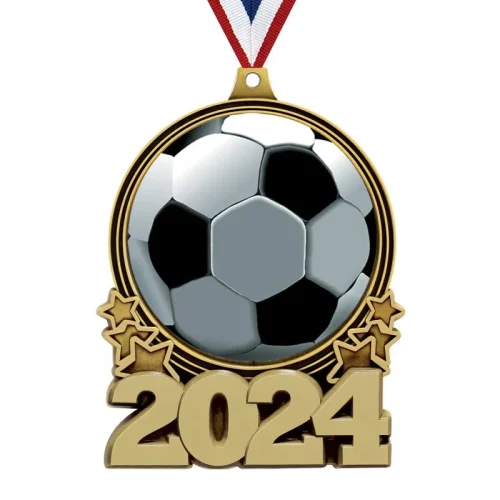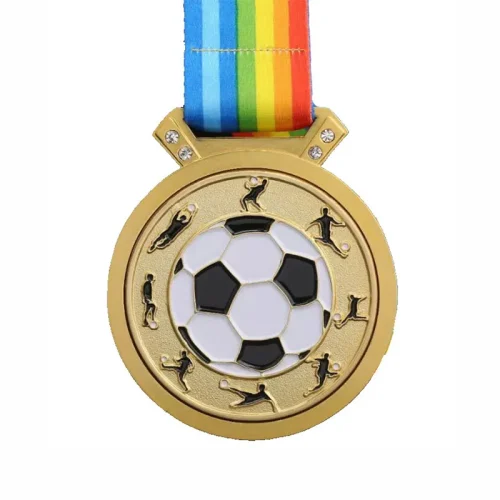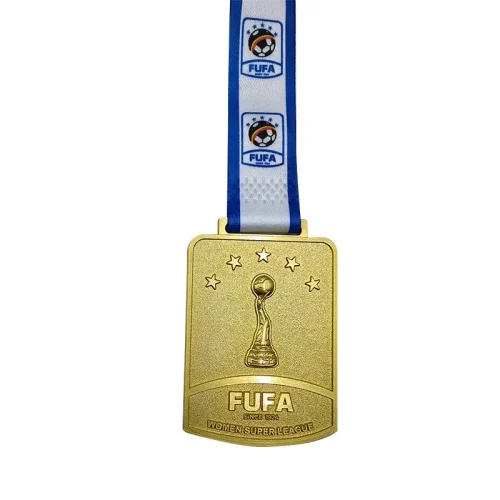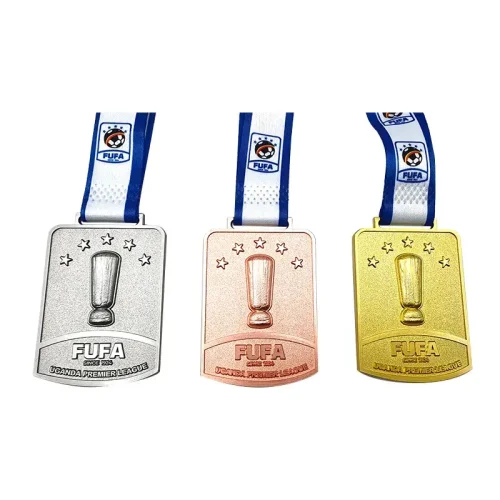Selama bertahun-tahun, desain medali sepak bola remaja telah berkembang secara signifikan. Awalnya, medali masih sederhana, sering kali menampilkan desain standar yang generik dan kurang memiliki makna pribadi. Namun, dengan kemajuan teknologi dan perubahan preferensi konsumen, telah terjadi pergeseran ke arah desain yang lebih personal dan terperinci. Saat ini, tim dan penyelenggara turnamen dapat memilih dari beragam pilihan kustomisasi, mulai dari logo yang rumit hingga ukiran yang dipersonalisasi yang menangkap esensi acara atau semangat tim.
Tren dalam Menyesuaikan Medali Sepak Bola untuk Tim dan Turnamen Remaja
Fitur Kustomisasi Populer
Jika menyangkut menyesuaikan medali sepak bola Bagi kaum muda, beberapa fitur tertentu sangat populer. Salah satu opsi kustomisasi yang paling banyak dicari adalah ukiran, di mana nama penerima, tim, atau acara diukir pada medali. Sentuhan pribadi ini membuat medali menjadi lebih bermakna bagi para atlet muda yang menerimanya. Selain itu, kustomisasi dapat diperluas ke pilihan bahan, dengan beberapa program memilih logam berkualitas tinggi seperti perunggu, perak, atau pelapisan emas untuk menambahkan sentuhan prestise. Skema warna yang sesuai dengan warna tim atau branding acara juga memainkan peran penting dalam kustomisasi, sehingga medali dapat mencerminkan identitas tim atau turnamen.
Memasukkan Identitas Tim dalam Desain Medali
Tren yang berkembang dalam kustomisasi medali sepak bola remaja adalah penggabungan identitas tim ke dalam desain. Hal ini dapat mencakup penggunaan logo tim, warna, dan bahkan moto pada medali. Dengan menyematkan elemen-elemen ini ke dalam desain, medali tidak hanya berfungsi sebagai penghargaan tetapi juga sebagai simbol semangat dan persatuan tim. Sebagai contoh, tim yang membanggakan diri dengan ketangguhannya dapat memilih untuk memasukkan simbol atau moto yang relevan ke dalam medali mereka, sehingga menciptakan hubungan yang langgeng antara penghargaan dan nilai-nilai inti tim.
Merancang Medali yang Menarik bagi Atlet Muda
Meskipun kustomisasi itu penting, desain medali juga harus menarik bagi para atlet muda yang akan menerimanya. Memahami preferensi mereka dan menyeimbangkan estetika dengan fungsionalitas adalah pertimbangan utama dalam proses ini.
Memahami Preferensi Atlet Muda
Atlet muda cenderung tertarik pada desain yang secara visual mencolok dan mencerminkan prestasi mereka dengan cara yang sesuai dengan mereka. Faktor-faktor seperti ukuran medali, warnanya, dan penggunaan gambar atau simbol yang dinamis dapat sangat memengaruhi daya tariknya. Misalnya, medali yang menampilkan bidikan aksi pemain sepak bola atau gambar dinamis desain bola sepak cenderung lebih menarik bagi para atlet muda daripada desain tradisional yang lebih statis. Untuk memastikan bahwa medali memenuhi harapan para penerima, beberapa program secara aktif mencari umpan balik dari para atlet selama proses desain, yang memungkinkan mereka untuk memiliki suara tentang bagaimana penghargaan mereka akan terlihat.
Menyeimbangkan Estetika dengan Daya Tahan
Meskipun medali harus menarik secara visual, medali juga harus tahan lama dan aman untuk atlet muda. Keseimbangan ini dicapai melalui pemilihan bahan dan teknik produksi yang cermat. Sebagai contoh, logam yang ringan namun kokoh sering dipilih untuk memastikan bahwa medali tidak terlalu berat bagi atlet muda untuk dipakai dengan nyaman. Selain itu, penggunaan lapisan akhir yang tidak beracun dan tepi yang halus sangat penting untuk mencegah cedera. Dengan memprioritaskan estetika dan keamanan, para desainer dapat menciptakan medali yang menarik dan praktis.
Memasukkan Elemen Inspirasional dan Motivasi
Cara lain untuk meningkatkan daya tarik medali sepak bola adalah dengan memasukkan elemen inspirasional dan motivasi ke dalam desain. Hal ini bisa termasuk mengukir kutipan motivasi, menambahkan gambar yang melambangkan kemenangan, atau menggunakan elemen desain yang menyampaikan rasa pencapaian. Fitur-fitur ini tidak hanya membuat medali lebih menarik secara visual, tetapi juga menambahkan dimensi emosional yang dapat menginspirasi atlet muda untuk terus mengejar tujuan mereka.
Studi Kasus Program Sepak Bola Usia Muda yang Berhasil
Untuk memahami dampak dari medali sepak bola pada pengembangan pemuda, akan sangat membantu untuk melihat contoh-contoh spesifik dari program-program yang berhasil. Studi kasus ini menyoroti bagaimana medali yang disesuaikan telah berkontribusi pada keberhasilan program-program ini dan pengembangan atlet mereka.
Program 1: Akademi Sepak Bola Rising Stars
Rising Stars Soccer Academy adalah program sepak bola remaja terkenal yang berfokus pada pengembangan atlet muda melalui kombinasi pelatihan keterampilan dan pendidikan karakter. Salah satu komponen utama dari program mereka adalah penggunaan medali khusus untuk mengenali dan memberi penghargaan kepada para atlet mereka. Medali-medali ini, yang menampilkan logo akademi dan desain unik untuk setiap acara, telah menjadi sangat didambakan oleh para peserta. Akademi melaporkan bahwa medali tersebut tidak hanya memotivasi para atlet untuk tampil lebih baik, tetapi juga membantu membangun rasa bangga dan memiliki di antara anggota tim. Keberhasilan pendekatan ini terbukti dengan tingkat retensi yang tinggi dan umpan balik positif dari para atlet dan orang tua.
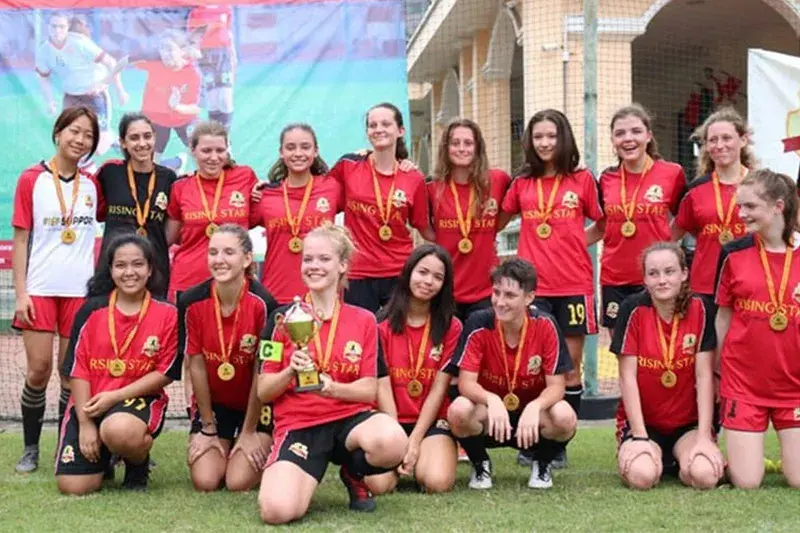
Program 2: Liga Pemuda Sepak Bola Global
Global Soccer Youth League adalah program sepak bola pemuda internasional yang menyelenggarakan turnamen di berbagai negara. Salah satu ciri khas dari program ini adalah penekanannya pada pertukaran budaya dan persahabatan global. Untuk memperkuat hal ini, liga ini menawarkan medali yang dirancang untuk mencerminkan keragaman budaya para peserta, dengan memasukkan elemen-elemen dari berbagai budaya ke dalam desainnya. Medali-medali ini telah memainkan peran penting dalam menumbuhkan rasa komunitas global di antara para peserta, menjadikan turnamen ini tidak hanya sebagai kompetisi tetapi juga sebagai perayaan pertukaran budaya. Keberhasilan liga dalam mempromosikan budaya sepak bola global melalui medali-medali ini telah menjadikannya sebagai model untuk program olahraga pemuda internasional lainnya.
Pelajaran yang Dipetik dari Program-program Ini
Dari studi kasus ini, beberapa pelajaran penting muncul untuk program sepak bola usia muda lainnya yang ingin menggabungkan medali yang disesuaikan. Pertama, jelas bahwa medali dapat menjadi motivator yang kuat jika dirancang dengan mempertimbangkan para atlet dan mencerminkan nilai-nilai program. Selain itu, penyesuaian medali dapat meningkatkan rasa identitas dan kebanggaan di antara para peserta, yang mengarah pada keterlibatan dan retensi yang lebih besar. Terakhir, penggunaan medali sebagai alat untuk mempromosikan pertukaran budaya dan persatuan global dapat menambah dimensi yang signifikan pada program sepak bola remaja, membantu memperluas wawasan para atlet muda.
Pentingnya Medali Sepak Bola Remaja dalam Mempromosikan Budaya Sepak Bola Global
Di luar dampak langsungnya terhadap atlet dan tim individu, medali sepak bola usia muda juga memainkan peran penting dalam mempromosikan budaya sepak bola global. Sebagai simbol pencapaian, medali ini membantu menghubungkan atlet muda dengan komunitas sepak bola yang lebih luas dan menumbuhkan rasa memiliki terhadap olahraga global.
Sepak Bola sebagai Olahraga Global
Sepak bola lebih dari sekadar olahraga; sepak bola merupakan fenomena global yang melampaui batas-batas budaya dan negara. Program sepak bola usia muda di seluruh dunia berperan penting dalam memperkenalkan olahraga ini kepada para atlet muda dan membantu mereka mengembangkan hasrat seumur hidup terhadap sepak bola. Dengan berpartisipasi dalam program-program ini dan menerima medali atas prestasi mereka, para atlet muda menjadi bagian dari komunitas sepak bola global, berbagi dalam tradisi yang diakui dan dirayakan di seluruh dunia.
Medali sebagai Simbol Pertukaran Budaya
Salah satu aspek unik dari sepak bola adalah kemampuannya untuk menyatukan orang-orang dari berbagai budaya dan latar belakang. Medali sepak bola pemuda dapat memainkan peran penting dalam pertukaran budaya ini dengan menjadi simbol nyata dari persahabatan dan pemahaman internasional. Sebagai contoh, dalam turnamen pemuda internasional, medali yang menggabungkan unsur-unsur dari budaya yang berbeda dapat membantu merayakan keragaman peserta dan mempromosikan rasa persatuan. Medali-medali ini menjadi lebih dari sekadar penghargaan; medali-medali ini merupakan kenang-kenangan yang mewakili hubungan yang dibuat dan pengalaman budaya yang dibagikan selama acara berlangsung.
Dampak Jangka Panjang dari Medali pada Atlet Muda
Dampak dari menerima medali sepak bola dalam program pemuda dapat jauh melampaui acara itu sendiri. Bagi banyak atlet muda, medali-medali ini menjadi kenang-kenangan berharga yang menginspirasi mereka untuk terus berpartisipasi dalam olahraga dan berjuang untuk menjadi yang terbaik. Medali-medali ini menjadi pengingat yang konstan akan apa yang dapat dicapai melalui kerja keras dan dedikasi, dan dapat memotivasi para atlet untuk mengejar sepak bola di tingkat yang lebih tinggi, baik di perguruan tinggi, liga profesional, atau bahkan di panggung global. Dengan cara ini, medali sepak bola remaja tidak hanya berkontribusi pada pengembangan atlet secara individu, tetapi juga pada pertumbuhan sepak bola sebagai olahraga global.


